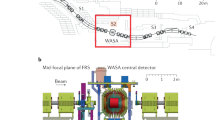Abstract
Hypernuclear research will be one of the main topics addressed by the PANDA experiment at the planned Facility for Antiproton and Ion Research FAIR at Darmstadt (Germany). Thanks to the use of stored \(\overline{p}\) beams, copious production of double Λ hypernuclei is expected at the PANDA experiment, which will enable high precision γ spectroscopy of such nuclei for the first time. At PANDA excited states of Ξ − hypernuclei will be used as a starting point for the formation of double Λ hypernuclei. In order to predict the yield of particle stable double hypernuclei a microcanonical decay model was developed. For the detection of these nuclei, a devoted hypernuclear detector setup is planned. This set-up consists, in addition to the general purpose of the PANDA set-up, of a primary nuclear target for the production of \(\Xi^{-}+\overline{\Xi}\) pairs, a secondary active target for the hypernuclei formation and the identification of associated decay products and a germanium array detector to perform γ spectroscopy. Furthermore, the presence of \(\overline{\Xi}\) can be used as an alternative to tag the strangeness in the \(\Xi^{-}+\overline{\Xi}\). All systems need to operate in the presence of a high magnetic field and a large hadronic background. In the present talk details concerning simulations, the identification procedure of double hypernuclei and the suppression of background will be presented. In addition, the present status of the detector developments for this programme will be briefly given.
Similar content being viewed by others
References
Physics Performance Report for PANDA: Strong Interaction Studies with Antiprotons. arXiv:0903.3905v1
Kerman, A.K., Weiss, M.S.: Phys. Rev. C 8, 408 (1973)
Botvina, A.S., Pochodzalla, J.: Phys. Rev. C 76, 024909 (2007)
Yamamoto, Y., Sano, M., Wakai, M.: Prog. Theor. Phys. Suppl. 117, 265 (1994)
Hirata, Y., et al.: Nucl. Phys. A 639, 389c (1998)
Yamamoto, Y., Wakai, M., Motoba, T., Fukuda, T.: Nucl. Phys. A 625, 107 (1997)
Hirata, Y., et al.: Prog. Theor. Phys. 102, 89 (1999)
Aoki, S., et al., KEK E176 Collaboration: Nucl. Phys. A 828, 191 (2009)
Yamada, T., Ikeda, K.: Phys. Rev. C 56, 3216 (1997)
Ohnishi, A., Hirata, Y., Nara, Y., Shinmura, S., Akaishi, Y.: Nucl. Phys. A 684, 595 (2001)
Ikeda, K., et al.: Prog. Theor. Phys. 91, 747 (1994)
Yamamoto, Y., Motoba, T., Fukuda, T., Takahashi, M., Ikeda, K.: Prog. Theor. Phys. Suppl. 117, 281 (1994)
Batty, C.J., Friedman, E., Gal, A.: Phys. Rev. C 59, 295–304 (1999)
Pochodzalla, J.: Nucl. Phys. A 754, 430c (2005)
Fermi, E.: Progr. Theor. Phys. 5, 570 (1950)
Sanchez Lorente, A., Botvina, A., Pochodzalla, J.: Phys. Lett. B 697, 222 (2011)
Bondorf, J.P., et al.: Phys. Rep. 257, 133 (1995)
Hiyama, E., et al.: Phys. Rev. 66, 024007 (2002)
Yamada, T., Ikeda, K.: Phys. Rev. C56, 3216 (1997)
Ferro, F., et al.: Nucl. Phys. A 789, 209 (2007)
Sanchez Lorente, A., et al.: Nucl. Instrum. Methods A 573, 410 (2007)
Bamberger, A., et al.: Nucl. Phys. B 60, 1 (1973)
Bedjidian, M., et al.: Phys. Lett. 62, 467 (1976)
May, M., et al.: Phys. Rev. Lett. 51, 2085 (1983)
Akikawa, H., et al.: Phys. Rev. Lett. 88, 082501-1 (2002)
Steinen, M.: Master Thesis, under preparation
Bleser, S.: PhD. Thesis, under preparation
J. M. Heuser, et al.: HadronPhysics2, http://hadronphysics2.eu, work package 26, ULISI
Author information
Authors and Affiliations
Consortia
Corresponding author
Rights and permissions
About this article
Cite this article
Sanchez Lorente, A., on behalf of the P̅ANDA Collaboration. Double Λ-hypernuclei at the PANDA experiment. Hyperfine Interact 213, 41–50 (2012). https://doi.org/10.1007/s10751-011-0394-5
Published:
Issue Date:
DOI: https://doi.org/10.1007/s10751-011-0394-5




